Xiaolong Jiang
Progressive Scaling Visual Object Tracking
May 26, 2025Abstract:In this work, we propose a progressive scaling training strategy for visual object tracking, systematically analyzing the influence of training data volume, model size, and input resolution on tracking performance. Our empirical study reveals that while scaling each factor leads to significant improvements in tracking accuracy, naive training suffers from suboptimal optimization and limited iterative refinement. To address this issue, we introduce DT-Training, a progressive scaling framework that integrates small teacher transfer and dual-branch alignment to maximize model potential. The resulting scaled tracker consistently outperforms state-of-the-art methods across multiple benchmarks, demonstrating strong generalization and transferability of the proposed method. Furthermore, we validate the broader applicability of our approach to additional tasks, underscoring its versatility beyond tracking.
WorldSense: Evaluating Real-world Omnimodal Understanding for Multimodal LLMs
Feb 06, 2025



Abstract:In this paper, we introduce WorldSense, the first benchmark to assess the multi-modal video understanding, that simultaneously encompasses visual, audio, and text inputs. In contrast to existing benchmarks, our WorldSense has several features: (i) collaboration of omni-modality, we design the evaluation tasks to feature a strong coupling of audio and video, requiring models to effectively utilize the synergistic perception of omni-modality; (ii) diversity of videos and tasks, WorldSense encompasses a diverse collection of 1,662 audio-visual synchronised videos, systematically categorized into 8 primary domains and 67 fine-grained subcategories to cover the broad scenarios, and 3,172 multi-choice QA pairs across 26 distinct tasks to enable the comprehensive evaluation; (iii) high-quality annotations, all the QA pairs are manually labeled by 80 expert annotators with multiple rounds of correction to ensure quality. Based on our WorldSense, we extensively evaluate various state-of-the-art models. The experimental results indicate that existing models face significant challenges in understanding real-world scenarios (48.0% best accuracy). We hope our WorldSense can provide a platform for evaluating the ability in constructing and understanding coherent contexts from omni-modality.
LamRA: Large Multimodal Model as Your Advanced Retrieval Assistant
Dec 02, 2024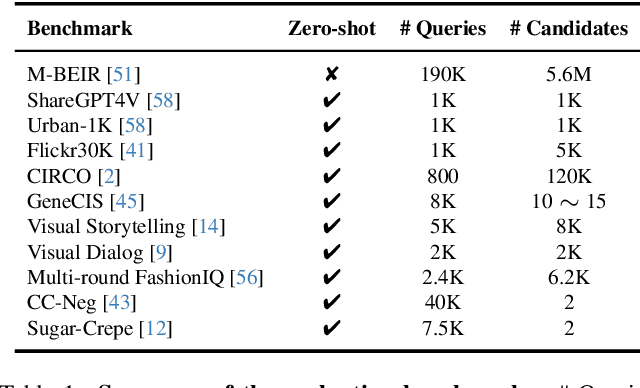
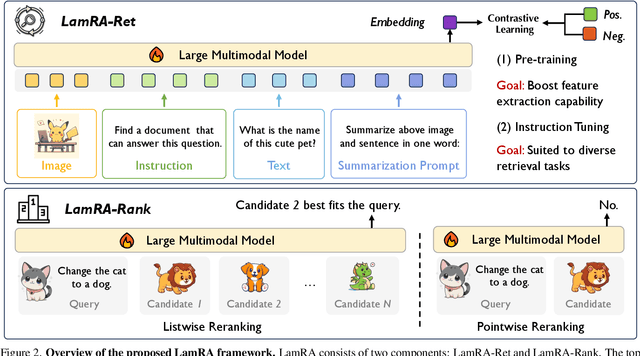
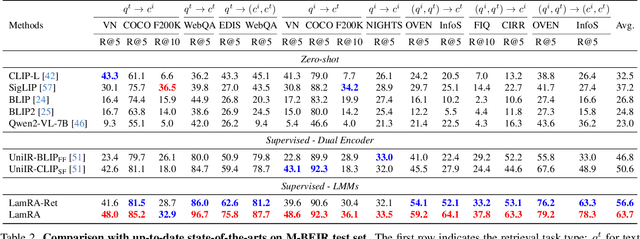
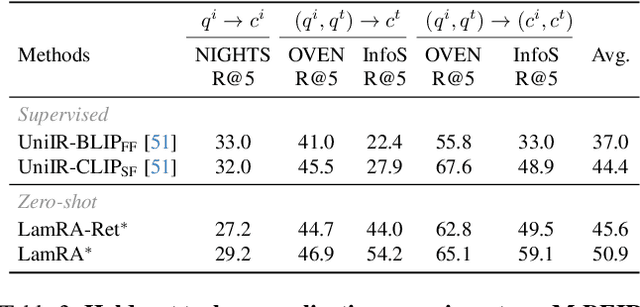
Abstract:With the rapid advancement of multimodal information retrieval, increasingly complex retrieval tasks have emerged. Existing methods predominately rely on task-specific fine-tuning of vision-language models, often those trained with image-text contrastive learning. In this paper, we explore the possibility of re-purposing generative Large Multimodal Models (LMMs) for retrieval. This approach enables unifying all retrieval tasks under the same formulation and, more importantly, allows for extrapolation towards unseen retrieval tasks without additional training. Our contributions can be summarised in the following aspects: (i) We introduce LamRA, a versatile framework designed to empower LMMs with sophisticated retrieval and reranking capabilities. (ii) For retrieval, we adopt a two-stage training strategy comprising language-only pre-training and multimodal instruction tuning to progressively enhance LMM's retrieval performance. (iii) For reranking, we employ joint training for both pointwise and listwise reranking, offering two distinct ways to further boost the retrieval performance. (iv) Extensive experimental results underscore the efficacy of our method in handling more than ten retrieval tasks, demonstrating robust performance in both supervised and zero-shot settings, including scenarios involving previously unseen retrieval tasks.
P4Q: Learning to Prompt for Quantization in Visual-language Models
Sep 26, 2024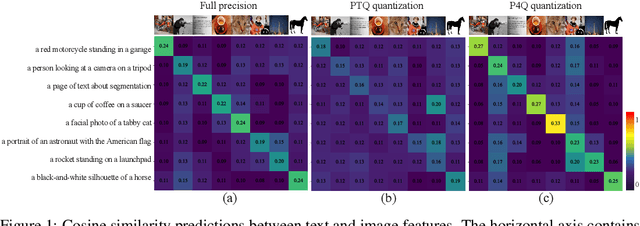
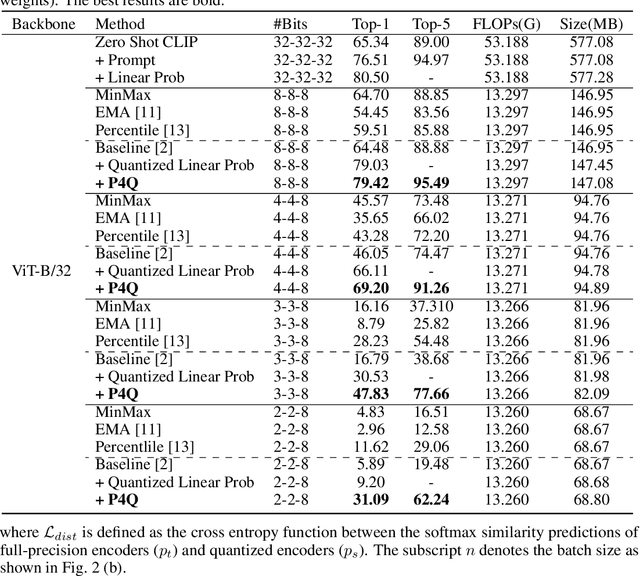
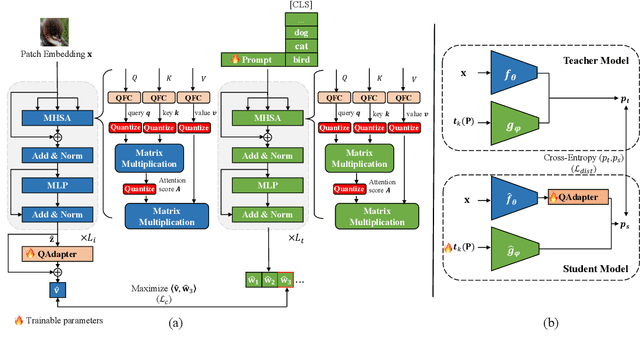
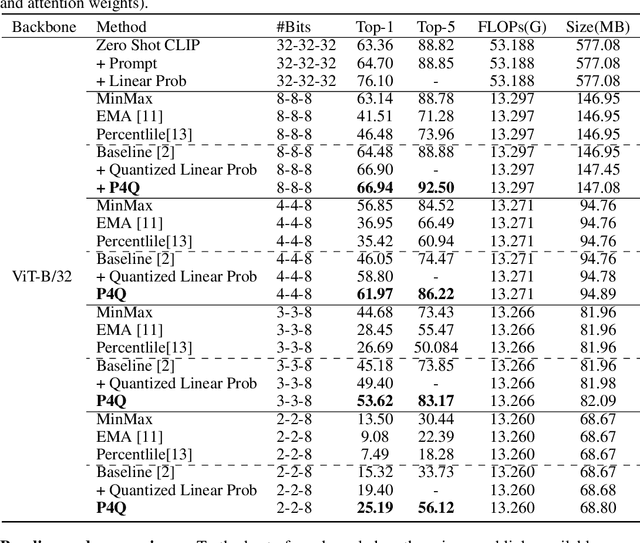
Abstract:Large-scale pre-trained Vision-Language Models (VLMs) have gained prominence in various visual and multimodal tasks, yet the deployment of VLMs on downstream application platforms remains challenging due to their prohibitive requirements of training samples and computing resources. Fine-tuning and quantization of VLMs can substantially reduce the sample and computation costs, which are in urgent need. There are two prevailing paradigms in quantization, Quantization-Aware Training (QAT) can effectively quantize large-scale VLMs but incur a huge training cost, while low-bit Post-Training Quantization (PTQ) suffers from a notable performance drop. We propose a method that balances fine-tuning and quantization named ``Prompt for Quantization'' (P4Q), in which we design a lightweight architecture to leverage contrastive loss supervision to enhance the recognition performance of a PTQ model. Our method can effectively reduce the gap between image features and text features caused by low-bit quantization, based on learnable prompts to reorganize textual representations and a low-bit adapter to realign the distributions of image and text features. We also introduce a distillation loss based on cosine similarity predictions to distill the quantized model using a full-precision teacher. Extensive experimental results demonstrate that our P4Q method outperforms prior arts, even achieving comparable results to its full-precision counterparts. For instance, our 8-bit P4Q can theoretically compress the CLIP-ViT/B-32 by 4 $\times$ while achieving 66.94\% Top-1 accuracy, outperforming the learnable prompt fine-tuned full-precision model by 2.24\% with negligible additional parameters on the ImageNet dataset.
Improving Synthetic Image Detection Towards Generalization: An Image Transformation Perspective
Aug 13, 2024



Abstract:With recent generative models facilitating photo-realistic image synthesis, the proliferation of synthetic images has also engendered certain negative impacts on social platforms, thereby raising an urgent imperative to develop effective detectors. Current synthetic image detection (SID) pipelines are primarily dedicated to crafting universal artifact features, accompanied by an oversight about SID training paradigm. In this paper, we re-examine the SID problem and identify two prevalent biases in current training paradigms, i.e., weakened artifact features and overfitted artifact features. Meanwhile, we discover that the imaging mechanism of synthetic images contributes to heightened local correlations among pixels, suggesting that detectors should be equipped with local awareness. In this light, we propose SAFE, a lightweight and effective detector with three simple image transformations. Firstly, for weakened artifact features, we substitute the down-sampling operator with the crop operator in image pre-processing to help circumvent artifact distortion. Secondly, for overfitted artifact features, we include ColorJitter and RandomRotation as additional data augmentations, to help alleviate irrelevant biases from color discrepancies and semantic differences in limited training samples. Thirdly, for local awareness, we propose a patch-based random masking strategy tailored for SID, forcing the detector to focus on local regions at training. Comparative experiments are conducted on an open-world dataset, comprising synthetic images generated by 26 distinct generative models. Our pipeline achieves a new state-of-the-art performance, with remarkable improvements of 4.5% in accuracy and 2.9% in average precision against existing methods.
VISA: Reasoning Video Object Segmentation via Large Language Models
Jul 16, 2024



Abstract:Existing Video Object Segmentation (VOS) relies on explicit user instructions, such as categories, masks, or short phrases, restricting their ability to perform complex video segmentation requiring reasoning with world knowledge. In this paper, we introduce a new task, Reasoning Video Object Segmentation (ReasonVOS). This task aims to generate a sequence of segmentation masks in response to implicit text queries that require complex reasoning abilities based on world knowledge and video contexts, which is crucial for structured environment understanding and object-centric interactions, pivotal in the development of embodied AI. To tackle ReasonVOS, we introduce VISA (Video-based large language Instructed Segmentation Assistant), to leverage the world knowledge reasoning capabilities of multi-modal LLMs while possessing the ability to segment and track objects in videos with a mask decoder. Moreover, we establish a comprehensive benchmark consisting of 35,074 instruction-mask sequence pairs from 1,042 diverse videos, which incorporates complex world knowledge reasoning into segmentation tasks for instruction-tuning and evaluation purposes of ReasonVOS models. Experiments conducted on 8 datasets demonstrate the effectiveness of VISA in tackling complex reasoning segmentation and vanilla referring segmentation in both video and image domains. The code and dataset are available at https://github.com/cilinyan/VISA.
A Sanity Check for AI-generated Image Detection
Jun 27, 2024


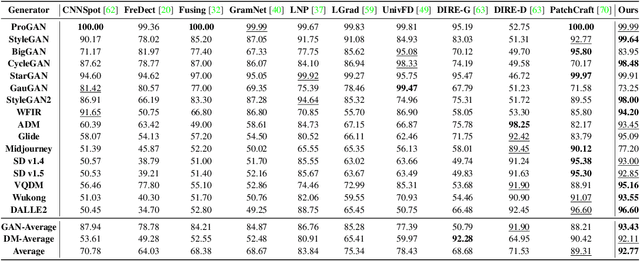
Abstract:With the rapid development of generative models, discerning AI-generated content has evoked increasing attention from both industry and academia. In this paper, we conduct a sanity check on "whether the task of AI-generated image detection has been solved". To start with, we present Chameleon dataset, consisting AIgenerated images that are genuinely challenging for human perception. To quantify the generalization of existing methods, we evaluate 9 off-the-shelf AI-generated image detectors on Chameleon dataset. Upon analysis, almost all models classify AI-generated images as real ones. Later, we propose AIDE (AI-generated Image DEtector with Hybrid Features), which leverages multiple experts to simultaneously extract visual artifacts and noise patterns. Specifically, to capture the high-level semantics, we utilize CLIP to compute the visual embedding. This effectively enables the model to discern AI-generated images based on semantics or contextual information; Secondly, we select the highest frequency patches and the lowest frequency patches in the image, and compute the low-level patchwise features, aiming to detect AI-generated images by low-level artifacts, for example, noise pattern, anti-aliasing, etc. While evaluating on existing benchmarks, for example, AIGCDetectBenchmark and GenImage, AIDE achieves +3.5% and +4.6% improvements to state-of-the-art methods, and on our proposed challenging Chameleon benchmarks, it also achieves the promising results, despite this problem for detecting AI-generated images is far from being solved. The dataset, codes, and pre-train models will be published at https://github.com/shilinyan99/AIDE.
Mining Open Semantics from CLIP: A Relation Transition Perspective for Few-Shot Learning
Jun 17, 2024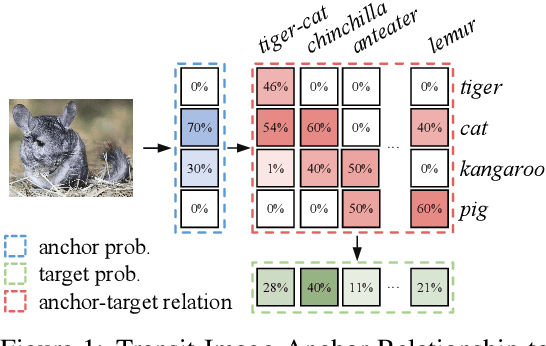

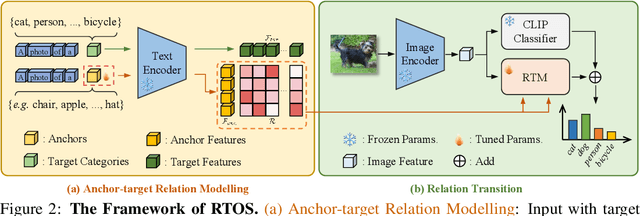
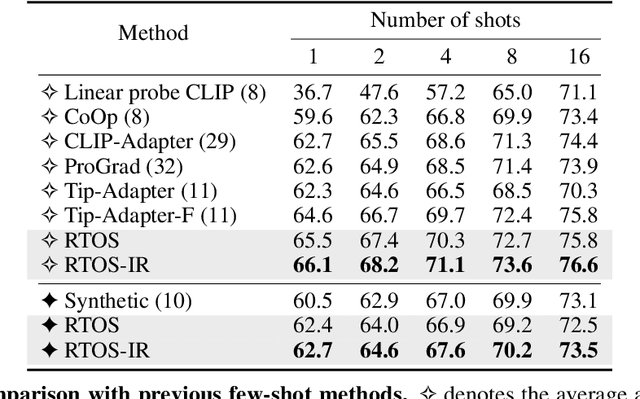
Abstract:Contrastive Vision-Language Pre-training(CLIP) demonstrates impressive zero-shot capability. The key to improve the adaptation of CLIP to downstream task with few exemplars lies in how to effectively model and transfer the useful knowledge embedded in CLIP. Previous work mines the knowledge typically based on the limited visual samples and close-set semantics (i.e., within target category set of downstream task). However, the aligned CLIP image/text encoders contain abundant relationships between visual features and almost infinite open semantics, which may benefit the few-shot learning but remains unexplored. In this paper, we propose to mine open semantics as anchors to perform a relation transition from image-anchor relationship to image-target relationship to make predictions. Specifically, we adopt a transformer module which takes the visual feature as "Query", the text features of the anchors as "Key" and the similarity matrix between the text features of anchor and target classes as "Value". In this way, the output of such a transformer module represents the relationship between the image and target categories, i.e., the classification predictions. To avoid manually selecting the open semantics, we make the [CLASS] token of input text embedding learnable. We conduct extensive experiments on eleven representative classification datasets. The results show that our method performs favorably against previous state-of-the-arts considering few-shot classification settings.
RSBuilding: Towards General Remote Sensing Image Building Extraction and Change Detection with Foundation Model
Mar 12, 2024



Abstract:The intelligent interpretation of buildings plays a significant role in urban planning and management, macroeconomic analysis, population dynamics, etc. Remote sensing image building interpretation primarily encompasses building extraction and change detection. However, current methodologies often treat these two tasks as separate entities, thereby failing to leverage shared knowledge. Moreover, the complexity and diversity of remote sensing image scenes pose additional challenges, as most algorithms are designed to model individual small datasets, thus lacking cross-scene generalization. In this paper, we propose a comprehensive remote sensing image building understanding model, termed RSBuilding, developed from the perspective of the foundation model. RSBuilding is designed to enhance cross-scene generalization and task universality. Specifically, we extract image features based on the prior knowledge of the foundation model and devise a multi-level feature sampler to augment scale information. To unify task representation and integrate image spatiotemporal clues, we introduce a cross-attention decoder with task prompts. Addressing the current shortage of datasets that incorporate annotations for both tasks, we have developed a federated training strategy to facilitate smooth model convergence even when supervision for some tasks is missing, thereby bolstering the complementarity of different tasks. Our model was trained on a dataset comprising up to 245,000 images and validated on multiple building extraction and change detection datasets. The experimental results substantiate that RSBuilding can concurrently handle two structurally distinct tasks and exhibits robust zero-shot generalization capabilities.
Controllable Mind Visual Diffusion Model
May 18, 2023Abstract:Brain signal visualization has emerged as an active research area, serving as a critical interface between the human visual system and computer vision models. Although diffusion models have shown promise in analyzing functional magnetic resonance imaging (fMRI) data, including reconstructing high-quality images consistent with original visual stimuli, their accuracy in extracting semantic and silhouette information from brain signals remains limited. In this regard, we propose a novel approach, referred to as Controllable Mind Visual Diffusion Model (CMVDM). CMVDM extracts semantic and silhouette information from fMRI data using attribute alignment and assistant networks. Additionally, a residual block is incorporated to capture information beyond semantic and silhouette features. We then leverage a control model to fully exploit the extracted information for image synthesis, resulting in generated images that closely resemble the visual stimuli in terms of semantics and silhouette. Through extensive experimentation, we demonstrate that CMVDM outperforms existing state-of-the-art methods both qualitatively and quantitatively.
 Add to Chrome
Add to Chrome Add to Firefox
Add to Firefox Add to Edge
Add to Edge